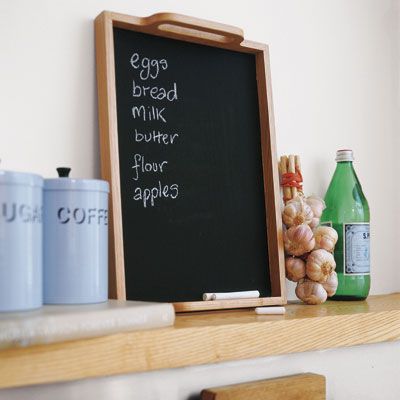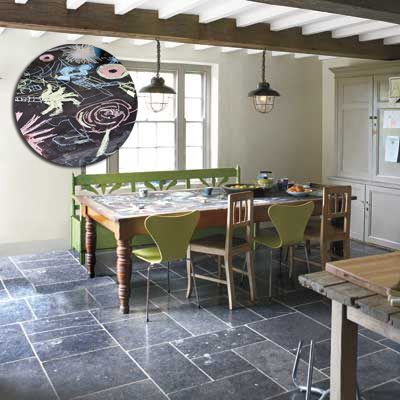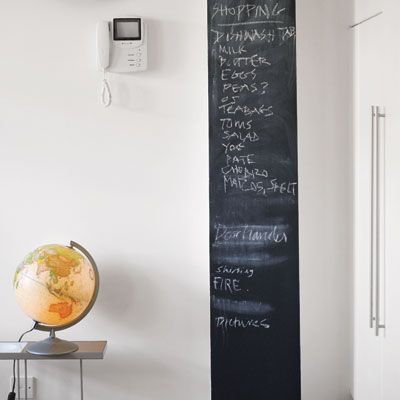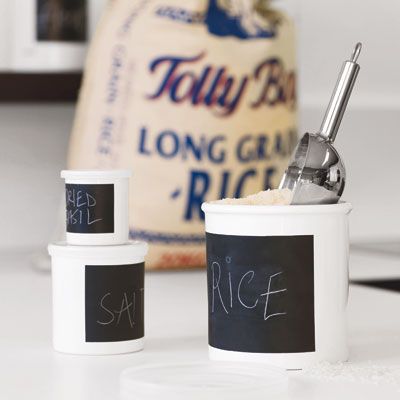Chalkboard paint allows you to transform ordinary surfaces into writable, erasable canvases, perfect for expressing your artistic side or keeping track of important information. This type of paint isn’t new, but creative minds keep coming up with new ways to use it.
Here are a few ideas to get you started on your own DIY chalkboard paint project.
1. Wall Calendar
To recreate this dramatic floor-to-ceiling calendar:
- Apply a base coat of standard gray chalkboard paint.
- Once dry, use a yardstick to draw squares in pencil.
- Carefully tape off the borders.
- Fill in three-quarters of the squares with different shades of light and medium gray, leaving the remaining squares the original wall color.
- The key to success with this project lies in coordinating the taping process. After painting the first set of squares, remove the tape, allow the paint to dry for 24 hours, then apply new tape to create the next set.

Once the paint has cured for a few days, your chalkboard calendar will be ready for use and should last for years.
Pro tip: Most chalkboard paint is classic deep gray, but you can easily customize the shade. Ask your local paint store to lighten a quart by adding white colorant. At home, you can blend dark and light shades to create a range of gray tones for your project.
2. Message Board
You can transform an ordinary wood tray into a message board with a simple application of chalkboard paint. This creates a reusable memo pad with a built-in resting place for chalk. It’s perfect for jotting down quick notes, creating to-do lists, or leaving messages for family members.
To create a chalkboard tray:
- Clean the tray thoroughly and sand it to create a smooth surface.
- Apply painter’s tape around the edges to protect the frame.
- Paint the tray’s interior with chalkboard paint.
- Once dry, remove the tape and condition the surface by rubbing the side of a piece of chalk over the entire painted area.
- Wipe clean with a dry cloth.

3. Scribble While You Wait
Budding artists can leave their mark on the kitchen table—without etching their name in ink. Applying chalkboard paint to your kitchen table can keep children entertained while waiting for meals or to encourage adults to unleash their creativity during gatherings.
When applying chalkboard paint to a table surface:
- Sand the table thoroughly to ensure proper paint adhesion.
- Apply a primer designed for use with chalkboard paint.
- Use a foam roller for a smooth finish, applying thin, even coats.
- Allow ample drying time between coats and before use.
- Condition the surface before first use by rubbing chalk over the entire area and wiping clean.

Keep several colored chalks handy, as well as a small eraser or damp cloth for easy cleanup.
4. Keep Track
Create a dramatic and functional feature in your home with a long strip of chalkboard paint. This allows you to unfurl your to-do list down the length of the wall.
To implement this design:
- Choose a wall that can accommodate a long, vertical strip.
- Use painter’s tape to mark off the desired area. Use a level to ensure the straightest lines.
- Apply chalkboard paint within the taped area.
- Once dry, remove the tape and condition the surface before use.

Pro tip: “A single coat of chalkboard paint should suffice, but if the surface gets lots of use, keep some handy for touch-ups.” —Carl Minchew, director of color technology, Benjamin Moore
5. Make Labels
Let opaque canisters reveal their contents with labels that are writ large and easily changed. This practical application lets you easily identify contents while maintaining a cohesive look in your pantry or on open shelving.
To create chalkboard labels on canisters:
- Clean the surface of the canister thoroughly.
- Apply painter’s tape to create the desired label shape and size.
- Paint the exposed area with chalkboard paint, applying thin, even coats.
- Once dry, remove the tape and condition the surface before writing.

This method allows you to change labels as needed, making it perfect for rotating seasonal ingredients or accommodating dietary changes. Use a chalk marker instead of regular chalk for cleaner, more precise writing.
